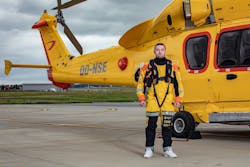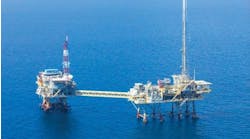Offshore staff
ABERDEEN, UK – Survitec has unveiled the Halo passenger lifejacket at the SPE Offshore Europe exhibition.
Incorporating a fully integrated emergency breathing system (EBS), featuring a carbon composite cylinder, braided low pressure hose and second stage with integrated nose clip, Halo is lighter than existing products.
At 949 g (2.1 lb) the bespoke Survitec EBS is 43% lighter than the company’s previous models and 30% lighter than competing emergency breathing systems. With a working pressure of 310 bar (4,496 psi), the company said, the composite cylinder provides 80% more breathable air than the industry minimum standard.
Nigel Parkes, Head of Lifejacket Design, Survitec, said: “Halo is the first aviation lifejacket to utilize Fusion 3D technology, allowing for a much more ergonomic jacket that adapts to the shape of the wearer for enhanced comfort. Particular attention has been paid to improving comfort around the neck and arms. This, combined with the lifejacket’s slimline profile and the reduction in EBS size, takes into consideration the restrictive space and movement within the helicopter cabin – allowing for greater freedom of movement for the wearer during transit.”
In response to customer feedback, the company has incorporated bright orange Hi-Vis beaded inflation toggles, allowing for quick and easy activation. A quick-lock front buckle and easy-to-adjust straps aide quick donning.
“From day-to-day wear to deployment in an emergency situation, intuitive use, and end-user experience have been central to Halo’s development,” said Parkes.
Should it need to be activated in-water, a buoyancy distribution system has been built in the lifejacket that is said to offer exceptional turning speeds and increased mouth freeboard. Rotating the wearer to a face-up position, in less than three seconds, it protects the wearer’s airway and improves both body angle and face plane, the company said.
The Halo also includes the new AU10-HTS personal location beacon (PLB) developed by Marine Rescue Technologies. This PLB can show all man-overboard casualties within AIS chart plotter areas, allowing search and rescue responses to be executed quickly and more effectively.
A strobe light, sealight light, whistle and reflective straps also help rescuers better locate the wearer. Once found, the rescuer can rapidly pull the survivor out of the water using the accessible lifting points on the front of the jacket.
The Halo passenger lifejacket is currently going through European Union Aviation Safety Agency approvals.
09/04/2019



